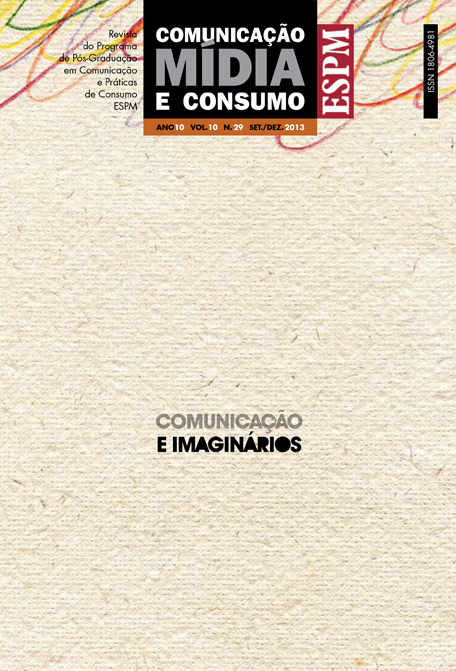The imaginary and the communication hypostasis
DOI:
https://doi.org/10.18568/cmc.v10i29.558Keywords:
Communication, Imaginary, School of GrenobleAbstract
This paper aims to review the definitions and vagueness of the conceptof imaginary and symbolic, and to relate its limits and its reach within the
research in Communication. The difficulties of the approach in Communication to a notion of course of the sense are addressed. Inherited from the School of Grenoble, this notion underlies the theory of the imaginary. Communication is here considered to be insufficient for the study of the catalysis of imaginaries and the production of symbolic images which are present in communication phenomena. This is due not only to the inadequacy of a process that is described in terms of sender – message – receiver, but especially to the self-e vidence of imaginary and
symbolic, as expressed in the language, resulting in a reduction of the imaginary to its social symptoms.
Downloads
References
BACHELARD, G. A água e os sonhos: ensaio sobre a imaginação da matéria. São Paulo:
Martins Fontes, 1998.
________. A poética do devaneio. São Paulo: Martins Fontes, 1988.
________. A psicanálise do fogo. São Paulo: Martins Fontes, 1999.
BADIA, D. D. Imaginário e ação cultural: as contribuições de Gilbert Durand e da Escola de
Grenoble. São Paulo, ECA-USP, 1993. Dissertação de mestrado.
BARROS, A. T. M. P. Communication et imaginaire: savoirs archaïques, pratiques contemporaines.
Sociétés, n. 115, p. 95-104, 2012.
BOURDIEU, P. Sobre o poder simbólico. In: O poder simbólico. Lisboa: DIFEL, 1989.
CASSIRER, E. A filosofia das formas simbólicas. São Paulo: Martins Fontes, 2001.
CASTORIADIS, C. A instituição imaginária da sociedade. Rio de Janeiro: Paz e Terra, 1982.
CORBIN, H. L’home et son ange. Paris: Fayard, 1983.
DURAND, G. A imaginação simbólica. Lisboa: Edições 70, 2000.
________. As estruturas antropológicas do imaginário: introdução à arquetipologia geral.
São Paulo: Martins Fontes, 1997.
________. Figures mythiques et visages de l’oeuvre. In: La sortie du XXe siècle. Paris:
CNRS Éditions, 2010. p. 187-504.
________. Les grands changements ou l’après Bachelard. In: Cahiers de l’Imaginaire:
l’Imaginaire dans les sciences et les arts. Toulouse: Privat, 1988.
________. Le retour des dieux. Cles, 2001. Disponível em: <http://www.cles.com/debats-
-entretiens/article/le-retour-des-dieux>. Acesso em: 18 jan. 2013.
________. Structures Éranos I. Paris: La Table Ronde, 2003.
KANT, E. Crítica da razão pura. São Paulo: Nova Cultural, 2005.
LACAN, J. Autres écrits. Paris: Éditions du Seuil, 2001.
________. O simbólico, o imaginário e o real. Discurso pronunciado em julho de 1953, na
fundação da Societé Française de Psychanalyse. Disponível em: <http://lacan.orgfree.
com/lacan/textos/simbolicoimaginarioreal.htm>. Acesso em: 20 nov. 2012.
LÉVI-STRAUSS, C. O pensamento selvagem. Campinas: Papirus, 2011.
LUHMANN, N. A improbabilidade da comunicação. Lisboa: Vega, 1992.
MAFFESOLI, M. Du nomadisme: vagabondages initiatiques. Paris: Le Livre de Poche, 1997.
_______. Elogio da razão sensível. Petrópolis: Vozes, 1998.
_______. Homo eroticus. Des communions émotionnelles. Paris: CNRS Éditions, 2012.
_______. O conhecimento comum. Porto Alegre: Sulina, 2007.
MON Oncle. Direção: Jacques Tati. Les Films de Mon Oncle, 2005. 1 DVD (109 min).
RICOEUR, P. Conflito das interpretações. Rio de Janeiro: Imago, 1978.
SERRA, J. P. Manual de teorias da Comunicação. Covilhã: Livros Labcom, 2007.
WUNENBURGER, J. J. L’imagination, mode d’emploi? Paris: Manucius, 2011.
_______. La vie des images. Strasbourg: Presses Universitaires de Strasbourg, 1995.
Downloads
Published
How to Cite
Issue
Section
License
Authors retain the copyright and grant the journal the right to first publication, with the work simultaneously licensed under the Creative Commons Attribution License that allows the work sharing with acknowledgment of authorship and initial publication in this magazine.








